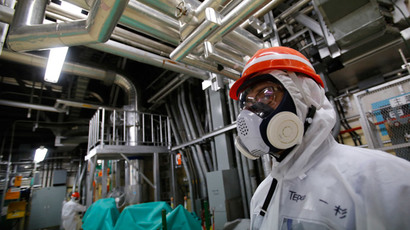Source of Fukushima’s nagging radioactive leak finally discovered – TEPCO

The source of the radioactive leak at the earthquake-stricken Fukushima Daiichi nuclear power plant was finally identified by the facility’s operator TEPCO to be in the primary containment vessel of reactor 3, authorities reported.
It was in January when the crew of the plant first noticed that water was leaking through to the drain on the first level of the building housing the reactor.
Engineers probed the space with a camera and found the water leakage to be near a pipe joint that connects directly to the containment vessel.
There is still water inside the containment vessel due to the ongoing flow of the coolant used to keep the stricken reactor’s temperature down.
The most likely scenario is that there’s more water in the vessel than there is in the area where the pipes enter it, the Tokyo Electric Power Company believes.
Before engineers can start decommissioning reactors 1, 2 and 3, which suffered meltdowns, they have to deal with the leakage. The coolant water comes out the other end mixed with radioactive waste. While it is possible to remove the radioactive fuel at this time, TEPCO wants to first plug the leak and fill up the space with more water as an additional measure against radiation.
TEPCO is at present trying to figure out the best strategy for plugging the leak.
The news comes just as the facility’s operator has ensured that the groundwater leakage issue (another problem) can also be solved by simply letting the water leak into the Pacific, instead of the cumbersome process of finding ways to store it, or block it from seeping into the ocean. The operation might take place by Wednesday next week.
To ensure that the water is indeed safe for release, TEPCO’s findings had to be backed up by the Japan Atomic Energy Agency and the Japan Chemical Analysis Center. What they found was that the feared presence of strontium-90 and cesium-134 and -137 was way below the health hazard threshold.
TEPCO is currently in talks with local authorities about
releasing the groundwater. About 560 tons is to be released in
the first round, which will only take about two hours, according
to an official with the Ministry of Economy, Trade and Industry.
But the water buildup continues, and the short-term storage tanks
that TEPCO has been relying on in the past are no longer a
solution, so the operator is to set up a bypass system to prevent
further buildup of the other, highly radioactive groundwater.
As for the load, that’s passed the safety test, local communities have been notified and an agreement was reached on releasing it into the Pacific Ocean as soon as possible.














